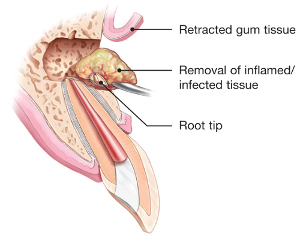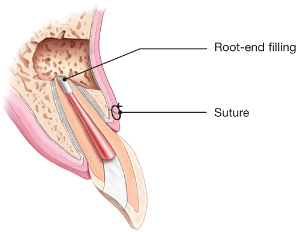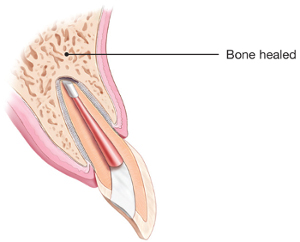ENDODONTICS EXPLAINED
Endodontists are specialists dedicated to saving your natural teeth.
- What is a Root Canal?
- How does endodontic treatment save the tooth?
- Tooth Pain
- Cracked Teeth
- Abscessed Teeth
- Traumatic Dental Injuries
- Knocked Out Teeth
Inside your tooth, beneath the white enamel and a hard layer called dentin, is a soft tissue called pulp. This tissue contains blood vessels, nerves and connective tissue, which help grow the root of your tooth during its development. A fully developed tooth can survive without the pulp because the tooth continues to be nourished by the tissues surrounding it.
Modern endodontic treatment is vastly different from its early days. It is now very similar to a routine filling and can usually be completed in one or two appointments, depending on the condition of your tooth and your personal circumstances. Getting a root canal is relatively painless and extremely effective. You will be back to smiling, biting and chewing with ease in no time.
Saving the natural tooth with root canal treatment has many advantages:
• Efficient chewing
• Normal biting force and sensation
• Natural appearance
• Protects other teeth from excessive wear or strain
It is necessary to have endodontic or root canal treatment when the inside of your tooth (the pulp) becomes inflamed or infected as a result of deep decay, repeated dental procedures, faulty crowns or a crack or chip in the tooth. Trauma to your tooth may also cause pulp damage even if the tooth has no visible chips or cracks. If pulp inflammation or infection is left untreated, in can cause pain or lead to an abscess.
When you undergo a root canal or other endodontic treatment, the inflamed or infected pulp is removed and the inside of the tooth is carefully cleaned and disinfected, then filled and sealed with a rubber-like material called gutta-percha. Afterwards, the tooth is restored with a crown or filling for protection and will continue to function like any other tooth.
Endodontic treatment helps you maintain your natural smile and continue eating the foods you love. It also limits the need for ongoing dental work. With proper care, most teeth that have had root canal treatment can last a lifetime.
Tooth pain—whether sharp and throbbing or dull and achy—makes it difficult to bite and chew, concentrate, get through the day and even sleep at night, no matter what over-the-counter medication you have taken for relief.
The source of tooth pain may be dental decay, an injury or an infection in the tooth. Regardless of the cause, if you have ongoing pain, it is time to see an endodontist for treatment. In the meantime, read on for information on common pain symptoms, possible causes and some steps you can take to ease the discomfort.
Whether your tooth cracks from an injury or general wear and tear, you can experience a variety of symptoms ranging from erratic pain when you chew your food to sudden pain when your tooth is exposed to very hot or cold temperatures. In many cases, the pain may come and go and your dentist may have difficulty locating the tooth causing the discomfort. If you experience these symptoms or suspect a cracked tooth, it’s best to see an endodontist as soon as possible.
Endodontists specialize in saving cracked teeth and will cater treatment to the type, location, and extent of the crack. The sooner your tooth is treated, the better the outcome. Once treated, most cracked teeth continue to function as they should, for many years of pain-free biting and chewing.
If your mouth or jaw is aching, if you experience pain while chewing, or if you have swollen gums, you may have an abscessed tooth. These are a few of the symptoms that can occur when the pulp (the soft tissue inside the root canal of a tooth) dies, becomes inflamed and goes untreated. The resulting infection in or around the root of the tooth may or may not be painful, but any ongoing symptoms should be tended by an endodontist who specializes in treating infected teeth and pulp.
An endodontist will typically treat your abscess with a root canal procedure or endodontic surgery. This involves removing the bacteria from the empty canals within your tooth, cleaning, shaping and filing the root canals, then sealing the empty space. Once endodontic treatment is performed, we highly recommend wasting little time to visit your dentist who will put a crown or other restoration on the tooth to protect and restore it to full function. After the dentist restores it the tooth will continue to function like your natural teeth.
Traumatic dental injuries often occur as a result of an accident or sports injury. The majority of these injuries are minor—chipped teeth. It is less common to dislodge your tooth or have it knocked completely out, but these injuries are more severe. Treatment depends on the type, location and severity of each injury. Regardless of the extent of the injury, your tooth requires immediate examination by an endodontist. Sometimes, your neighboring teeth suffer an additional, unnoticed injury that can only be detected by a thorough dental exam.
Endodontists are dentists who specialize in treating traumatic dental injuries. With their advanced skills, techniques and technologies they often can save injured teeth. If you have a cracked or injured tooth, find an endodontist near you right away. Most endodontists offer tremendous flexibility in accommodating emergency cases. You will have relief from your pain and likely save your tooth, so act as quickly as possible.
More than five million teeth are knocked out every year in children and adults but if this happens to you due to an injury or accident it doesn’t necessarily mean it’s lost for good. Proper emergency action can save the tooth so that it can be replanted successfully and last for years to come.
Act quickly, within 30 minutes, and visit the nearest dentist or endodontist.
Review and remember these tooth-saving steps that take you and your tooth from the time it falls out until you reach medical support:
1. Pick up the tooth by the crown (the chewing surface) NOT the root.
Locate the tooth immediately; don’t leave it at the site of the accident. Handle the tooth carefully when you pick it up, and never touch the root of the tooth, only the crown (chewing surface).
2. If dirty, gently rinse the tooth with water.
Use only water to gently rinse off any dirt. Do not use soap or chemicals. Don’t scrub or dry the tooth, and don’t wrap the tooth in a tissue or cloth.
3. Reposition the tooth in the socket immediately, if possible.
Try to put the tooth back into its socket right away. Gently push it in with your fingers, by handling the crown, or position it above the socket and close your mouth slowly. Hold the tooth in place with your fingers or by gently biting down on it.
4. Keep the tooth moist at all times.
The tooth must stay moist at all times, either in your mouth or, if it can’t be replaced in the socket, put it in milk, in your mouth next to your cheek, or in an emergency tooth preservation kit (such as Save-a-Tooth®). Don’t use regular tap water; root surface cells can’t tolerate that for extended periods of time.
5. See an endodontist or dentist within 30 minutes of the injury.
Bring the tooth with you to your emergency appointment ideally. It’s best to see the doctor within 30 minutes; however, it is possible to save a tooth even if it has been outside the mouth for an hour or more.
WHAT IS AN APICOECTOMY?
In this procedure, the endodontist opens the gum tissue near the tooth to see the underlying bone and to remove any inflamed or infected tissue. The very end of the root is also removed.

A small filling may be placed in the root to seal the end of the root canal, and a few stitches or sutures are placed in the gingiva to help the tissue heal properly.

Over a period of months, the bone heals around the end of the root.






